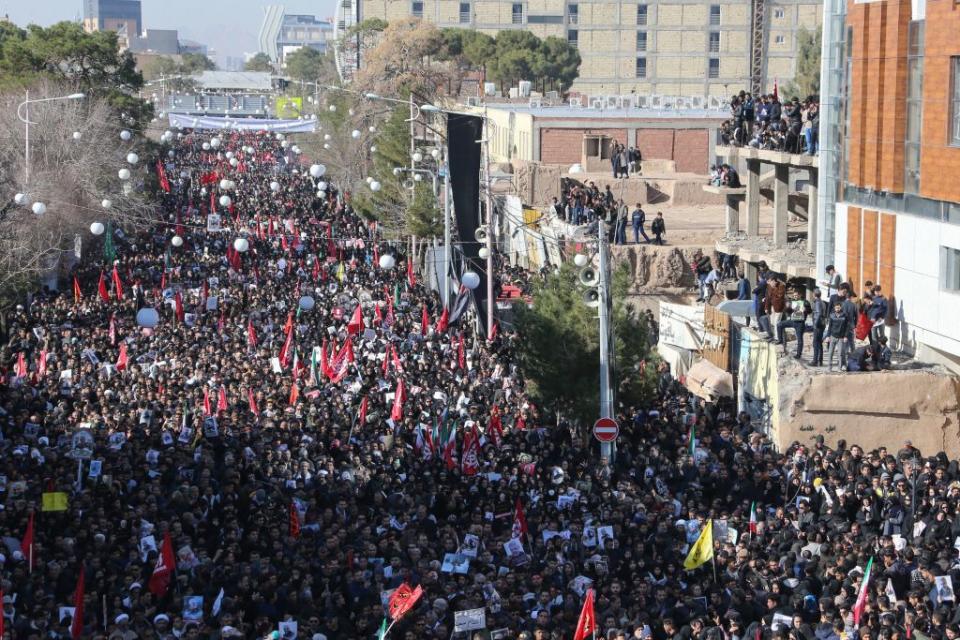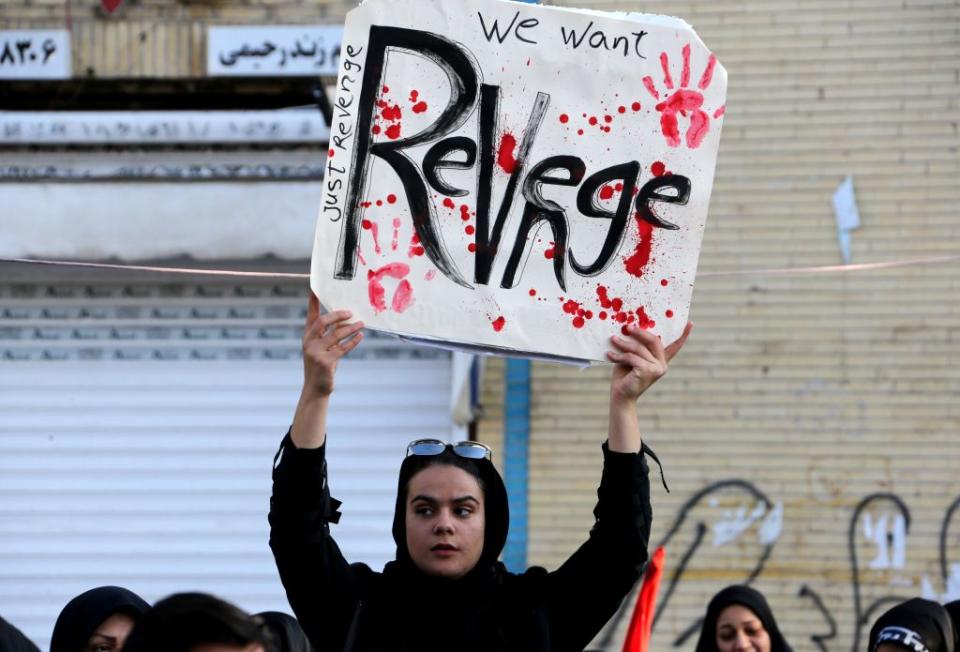'Blood and treasure': How a war between Iran and the US could unfold
In the wake of Iran launching missiles ostensibly aimed at US troops at military bases in Iraq, the world is nervously wondering if it’s listening to the deafening drumbeat of war.
After months of rising tensions, including a New Year’s Eve attack by Iran-backed militias on the US Embassy in Baghdad, the White House made a decision last week that shocked many, and pushed the US and Iran to the precipice of war.
By killing General Qasem Soleimani, head of Iran’s elite Quds Force, a special unit in Iran's Revolutionary Guards, the US knew it would provoke a strong retaliation from Iran.
The question now is what happens next.

No US casualties means world dodges major bullet
Iran launched more than a dozen missiles at two bases in Iraq – including the Ain Assad air base housing US troops – which has been described as the “operational beating heart” of the western mission in Iraq and Syria in the fight against the Islamic State.
There were no injuries or deaths to US personnel with some intelligence officials suggesting deaths were intentionally avoided by Iran.
“At this stage there doesn’t appear to be any US casualties, this is probably more likely a situation that can be managed to avoid escalation that both sides don’t want,” Dr Ben Rich, a Middle East expert from Curtin University said.
Given the beloved nature of general Soleimani, whose funeral was watched live on TV by millions, Iran had little choice but to respond with a show of force.
“I think the Iranians feel like they symbolically, particularly for domestic reasons, had to strike back in a rather demonstrable way,” Dr Rich told Yahoo News Australia.

“This was done for widespread consumption. There may be (attacks) in the future that will be more targeted and more a demonstration to the political leadership of the United States.
“Something that might be more damaging but also difficult to respond to.”
Such attacks could be carried out by Iran-backed militias or terror groups, or could be cyber in nature.
What does an escalation of hostilities look like?
Prior to Wednesday’s attack, the US Army moved 3,500 paratroopers from its storied 82nd Airborne Division to the region. Kuwait is the first stop for many but their final destinations are classified.
“We’re going to war bro,” one excited soldier exclaimed before shipping out, according to a Reuters journalist embedded with the division.
But this is a standard move from the US given the circumstances, Dr Rich said.
“I don’t think that that’s necessarily clear evidence that the US is getting ready to engage in a conventional conflict with Iran,” he said.
“But rather more likely they are just putting those troops in place as a kind of threat to hang over the Iranians to essentially say ‘be very, very careful about what your next steps are’.”
'God help us': Shock assassination puts the US on 'precipice of war'
Iran launches rockets at US troops on Iraqi bases in 'revenge operation'
'Bring us his head': Chilling $100m threat at assassinated leader's funeral

In terms of firepower, there is no question that the US would decimate Iran in a traditional military shoot out but a boots-on-the-ground conflict would be very difficult and deadly for US forces.
David Kilcullen, an Australian military strategist and the former chief strategist in the Office of the Coordination for Counter-terrorism at the US State Department, believes an escalation would involve non-traditional forms of conflict.
“I think we will not necessarily see a conventional war develop,” he told ABC TV from Denver on Wednesday.
“It will be morph into more of a hybrid conflict that incorporates lots of terrorist activity, lots of targeted assassinations, bombings, potentially attacks on diplomatic posts, and all that will happen in parallel with military operations on the ground in Iraq, and Syria and potentially other parts of the Middle East.”
War would be ‘apocalyptic’
Dr Rich believes the ongoing response from Iran will be unpredictable but “calibrated to keep the tension below a certain threshold”.
“The Iranians are very much aware that while they do have this very capable military ... certainly in terms of supporting proxy groups abroad and threatening asymmetrical responses, they know if there was a real throw down between them and the United States, they will lose very quickly.”
Others fear things could get out of hand.
Former CNN correspondent Michael Ware – who has spent time in Iraq, including the bases that were attacked on Wednesday – said a war in Iran would be “apocalyptic”.
“That's such a nightmare, I really don't want to have to contemplate it,” he told the ABC.
“But it would have to take something truly, truly significant for a full-blown war.
“Iran has 80 million people. It has two militaries, two armies, two navies, two air forces,” he said.
“Air strikes alone, whether it be Israeli or American, will not cripple the Iranian military apparatus.
“So, the prospects of a war in Iran are apocalyptic.”

Could the US ever invade Iran?
As utterly unlikely as it may be, “if the US went all the way and wanted to do a regime change, that would be an occupation that would make the Iraqi occupation look like a day at the races,” Dr Rich told Yahoo News.
That remains an extraordinarily unlikely outcome. The country is very mountainous and has a large and extremely defiant and galvanised population.
But it’s not entirely outside of the range of possibilities.
“People would have said the invasion of Iraq without provocation would have been an impossibility too, but unfortunately we life in a world where impossibilities come to pass,” Dr Rich said.
However he added that the “subsequent investment of blood and treasure would be ruinous” for US forces if they tried to occupy Iran.

Would Australia join a war effort?
Scott Morrison on Wednesday confirmed Australian troops and diplomats have been confirmed safe and said defence chief Angus Campbell had been told to do whatever is necessary to keep Australians safe.
But it remains to be seen if the Australian government will provide unequivocal support to US military operations, if asked.
“That's a matter for the Australian Parliament and for the Prime Minister in consultation with the military advisers, but my view is that we certainly did not sign up for a war in Iran,” Mr Kilcullen told ABC.
Australia’s current operation in Iraq is about countering Islamic State and about supporting the Iraqi military in its efforts to become more capable in that mission.
“Frankly that has nothing to do with a war between Iran and the United States,” he said.

According to Mr Kilcullen, it’s not so much Australian ground troops in Taji, northwest of Baghdad, that would be at risk, but rather naval forces in the North Arabian Gulf who could potentially be caught up in a maritime conflict.
“That of course is of direct consequence to Australia because of the degree to which we depend on oil and gas coming from that region,” he said.
“Certainly you could make the case that Australia should think of this as a very important issue that it needs to be involved in, but I think it is a very long stretch from that to saying we should automatically support military action against Iran.”
Do you have a story tip? Email: newsroomau@yahoonews.com.
You can also follow us on Facebook, Instagram and Twitter and download the Yahoo News app from the App Store or Google Play.




